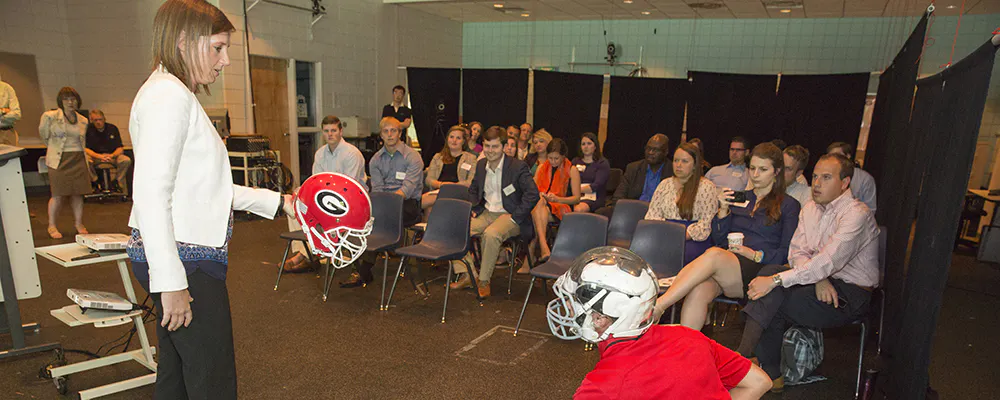Concussion research gives players a heads up
When Georgia Bulldogs outside linebacker Brandon Burrows was hit on the practice field last year, the force of the injury went straight to his head.
"I wasn't able to see, really," he says. "And the left side of my body felt numb, nearly limp. I had been hit, and I was stumbling around."
Burrows had a concussion, one of the most serious health issues now affecting all levels of football players. A recent $870 million settlement between the National Football League and more than 5,000 former players who filed concussion-related lawsuits against the organization is just one of the effects these injuries have on the sport. The Centers for Disease Control and Prevention reports there are an estimated two to two million sport-related concussions each year, and when left without treatment this repetitive head trauma can lead to permanent brain injury.
Which is why Julianne Schmidt, a professor in the College of Education's kinesiology department, hopes her studies of sport-related concussions will help reduce those numbers. By using a dynamic balance measure, a vision test that shows visual reaction time, and a neuropsychological test that measures memory and reaction time, Schmidt conducts pre-season assessments on all UGA football players. This information is used throughout the season to evaluate any possible concussion effects.
"Head impacts will always accidentally occur in sport," she says, adding that proper tackling techniques are one way to minimize head trauma. "A heads-up tackling technique should be taught at a young age. Players should be seeing what they hit and not lowering their heads. The head should not be the first and only point of contact with another player."
For her research, Schmidt wired 25 football players' helmets with sensors that measure impact severity, hit location and frequency. Information from the sensors feeds into players' athletic profiles, indicating who's being hit and where the contact was made on the helmet. This allows coaches to talk to players about dangerous habits.
Schmidt is also studying the influence of non-concussive head impacts on players' short- and long-term health. "Using that data, we can identify players who are sustaining a lot of high-magnitude head impacts or a lot of impacts to certain locations," says Schmidt. "Down the road, we hope to track players to determine whether their exposure to head impacts plays a role in their brain function later in life."
Rule changes influenced by recent concussion research are making the game safer. Rules for the kickoff favor touchbacks by moving the players to the 35-yard line and the ball to the 25-yard line. And new targeting guidelines prevent players from making contact with the top of the helmet, encouraging them to pick their heads up.
"This research will help drive future rule changes and ways to prevent concussions," says Schmidt. "Once we identify play types or play features that result in more severe head impacts, then we can compare offense to defense to special teams. This was the kind of research that led to the 2012 NCAA kickoff rule change."
Schmidt's past research has led to rule changes among high school and youth football programs. Before joining the College of Education faculty in 2013, Schmidt received her doctorate at the University of North Carolina at Chapel Hill where she examined whether high school and college linemen with larger, stronger neck muscles had reduced odds of sustaining more severe head impacts. As a result, local high schools, as well as USA Football, the governing body for youth football, are looking to her research to teach players and coaches about safer playing techniques.
Most concussions heal within seven to 10 days, but student athletes face an additional challenge. If they go to class, their symptoms often get worse.
"It's like running on an injured knee. It would hurt if you ran on it, which is an indicator that you put too high a load on that knee," Schmidt says. "It is the same thing if you go into a classroom with a concussion. You have to remember things to study for an exam, and it is putting too much load on the brain that is trying to repair itself."
And while football is a collision sport, this new research will help players like Burrows, and thousands of others, reduce or prevent concussions. And that could be a game-changer.
